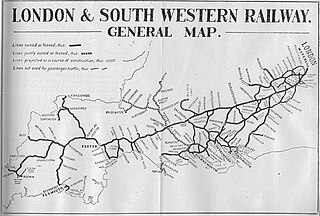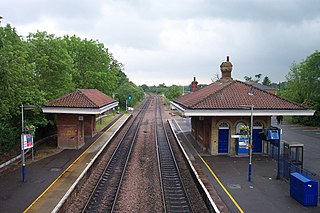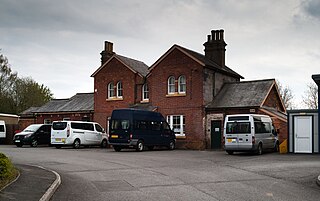
The London and South Western Railway was a railway company in England from 1838 to 1922. Originating as the London and Southampton Railway, its network extended to Dorchester and Weymouth, to Salisbury, Exeter and Plymouth, and to Padstow, Ilfracombe and Bude. It developed a network of routes in Hampshire, Surrey and Berkshire, including Portsmouth and Reading.

Yeovil Junction is the busier, but less central, of two railway stations serving the town of Yeovil in Somerset, England; the other is Yeovil Pen Mill. The station is sited 2 miles (3.2 km) outside the town, in the village of Stoford; although Yeovil is in Somerset, the station was in Dorset until 1991. It is located 122 miles 48 chains (197.3 km) down the line from London Waterloo.

The Wessex Main Line is the railway line from Bristol Temple Meads to Southampton Central. Diverging from this route is the Heart of Wessex Line from Westbury to Weymouth. The Wessex Main Line intersects the Reading to Taunton Line at Westbury and the West of England Main Line at Salisbury.

Yeovil Pen Mill is one of two railway stations that serve the town of Yeovil, Somerset, England. It is situated just under a mile to the east of the town centre. The station is located 59.5 miles (96 km) south of Bristol Temple Meads, on the Heart of Wessex Line. It is managed by Great Western Railway, who operate services along with South Western Railway.

Salisbury railway station serves the cathedral city of Salisbury in Wiltshire, England. It is 83 miles 43 chains (134.4 km) from London Waterloo on the West of England line to Exeter St Davids. This is crossed by the Wessex Main Line from Bristol Temple Meads to Southampton Central. The station is operated and served by South Western Railway (SWR), and is also served by Great Western Railway (GWR).

Plymouth Millbay railway station was the original railway terminus in Plymouth, Devon, England. It was used for passenger trains from 1849 to 1941. It was rebuilt in 1903.
The Wilts, Somerset and Weymouth Railway (WS&WR) was an early railway company in south-western England. It obtained Parliamentary powers in 1845 to build a railway from near Chippenham in Wiltshire, southward to Salisbury and Weymouth in Dorset. It opened the first part of the network but found it impossible to raise further money and sold its line to the Great Western Railway (GWR) in 1850.

Codford railway station was an intermediate station on the Salisbury branch line of the Great Western Railway built along the Wylye valley to connect Warminster and Salisbury to serve the surrounding villages, and situated along the lane from Codford St Peter to Boyton.

The Southampton and Dorchester Railway was an English railway company formed to join Southampton in Hampshire with Dorchester in Dorset, with hopes of forming part of a route from London to Exeter. It received parliamentary authority in 1845 and opened in 1847.
This article describes the history and operation of the railway routes west of Salisbury built by the London and South Western Railway (LSWR) and allied companies, which ultimately became part of the Southern Railway in the United Kingdom. Salisbury forms a natural boundary between the Southern Railway core routes in the counties surrounding London, and the long route connecting with the Devon and Cornwall lines.

The Berks and Hants Railway comprised two railway lines built simultaneously by the Great Western Railway (GWR) south and west from Reading in an attempt to keep the London and South Western Railway (LSWR) out of the area that it considered to be its territory in England.

Wilton South railway station is a disused railway station which served Wilton in Wiltshire, England, on the West of England line from London Waterloo to Exeter.
Wilton North railway station is a former railway station serving Wilton, Wiltshire, England. The station was opened in 1856 by the Great Western Railway on its Salisbury branch from Westbury. It was closed to passengers in 1955 and completely in 1965.

Heytesbury railway station is a former railway station near Heytesbury, Wiltshire, England, in the Wylye Valley, about three miles south of Warminster.

Chard Central railway station was the principal railway station in Chard, Somerset, England. It was opened in 1866 and closed in 1962, during which time it was known by three different names.
The Stert and Westbury Railway was opened by the Great Western Railway Company in 1900 in Wiltshire, England. It shortened the distance between London Paddington station and Weymouth, and since 1906 has also formed part of the Reading to Taunton line for a shorter journey from London to Penzance.
The Salisbury and Yeovil Railway linked Salisbury (Wiltshire), Gillingham (Dorset) and Yeovil (Somerset) in England. Opened in stages in 1859 and 1860, it formed a bridge route between the main London and South Western Railway (LSWR) network and its lines in Devon and Cornwall. Its trains were operated by the LSWR and it was sold to that company in 1878. Apart from a short section in Yeovil it remains open and carries the London Waterloo to Exeter service of South Western Railway.

The Reading–Taunton line is a major branch of the Great Western Main Line from which it diverges at Reading railway station. It runs to Cogload Junction where it joins the Bristol to Exeter and Penzance line.
The Yeovil–Taunton line was a railway line in England, built by the Bristol and Exeter Railway (B&ER) to connect its main line with the market town of Yeovil in Somerset. It opened in 1853, using the broad gauge of 7 ft 1⁄4 in and was the first railway to serve Yeovil. It ran from a junction at Durston although, in later years, passenger trains on the line ran through to and from Taunton where better main and branch line connections could be made.
The Eastleigh to Salisbury line is the railway line from Eastleigh (Hampshire) through Romsey to Salisbury (Wiltshire) in England. It was constructed by the London and South Western Railway in 1857 from Bishopstoke; the station's name was changed to Eastleigh in 1889. At Salisbury the line ran to Milford station on the south-eastern margin of the city, but in 1859 an extension to the present-day Salisbury station was built, and the lines from Andover through Salisbury to Yeovil were connected.














